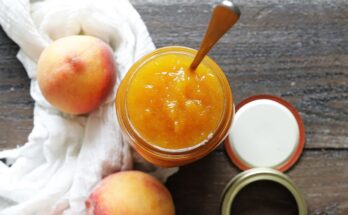Latte Recipe: If you’ve ever walked into a coffee shop, chances are you’ve seen the word “latte” plastered all over the menu. But what exactly is a latte? Simply put, a latte is a creamy coffee drink made with espresso and steamed milk. The name “latte” comes from the Italian “caffè latte,” which means “milk coffee.” It’s beloved worldwide for its smooth texture and balanced flavor. Unlike a cappuccino, which has a lot of foam, a latte has a thinner layer of foam and more milk, making it less intense and more mellow. This balance is perfect for those who enjoy the taste of coffee but prefer it softened by the richness of milk.
Lattes can be customized endlessly. From flavored syrups like vanilla and caramel to plant-based milk like oat or almond, your options are practically limitless. Whether you need a gentle start to your morning or a cozy drink on a rainy afternoon, a latte fits the bill. It’s no wonder this simple yet sophisticated drink has captured the hearts of millions around the globe.
History of the Latte
The origins of the latte are as rich as the drink itself. While milk and coffee have been paired for centuries, the modern latte emerged from Italian cafes, where “caffè latte” became a staple morning beverage. Unlike the American version, the Italian latte typically contains more milk and is less likely to feature fancy foam art.
In the United States, the latte gained serious popularity in the 1980s, thanks in part to the rise of specialty coffee shops like Starbucks. American coffee culture adapted the traditional Italian concept, making it larger, sweeter, and customizable. Today, the latte isn’t just a drink—it’s a lifestyle. From pumpkin spice to lavender-infused versions, the latte has become a canvas for creativity and personal expression.
Essential Ingredients for a Latte
Coffee Beans
Choosing the right coffee beans is crucial when crafting the perfect latte. Since espresso forms the backbone of a latte, selecting quality beans can make or break your drink. Ideally, you’ll want to opt for medium to dark roast beans. These roasts offer a full-bodied, rich flavor that stands up well against the creaminess of steamed milk.
When possible, go for freshly roasted beans. Freshness ensures that the coffee’s essential oils and flavors are at their peak. Grinding the beans right before brewing also greatly enhances the taste. A fine grind is necessary for making espresso, allowing the hot water to extract a concentrated shot packed with flavor. Popular choices for espresso beans include blends from Ethiopia, Colombia, and Brazil, each bringing its unique flavor profile to your cup.
Milk Choices
Milk isn’t just an accessory to your latte—it’s a starring player. Traditional lattes use whole cow’s milk because its fat content produces a velvety, rich texture when steamed. However, if you’re lactose intolerant, vegan, or simply adventurous, there are plenty of alternative milks to try.
Here are a few options:
- Oat Milk: Creamy and slightly sweet, it’s a favorite for creating foam.
- Almond Milk: Nutty and light, though it can sometimes be harder to froth.
- Soy Milk: Smooth and slightly sweet, it holds foam reasonably well.
- Coconut Milk: Offers a tropical twist, though it’s thinner and can separate.
Each milk choice brings a different flavor and texture to your latte, so don’t be afraid to experiment and find what suits your taste buds best.
Equipment You’ll Need
Espresso Machine
At the heart of a true latte is a rich, bold shot of espresso. For that, you’ll need an espresso machine. These machines force hot water through finely-ground coffee under high pressure, extracting an intense, flavorful shot. While high-end machines can be pricey, there are also budget-friendly options that still do a fantastic job for home brewing.
When shopping for an espresso machine, consider:
- Pump pressure: 9 bars of pressure is ideal.
- Built-in grinder: Freshly ground beans make a huge difference.
- Steam wand: Essential for frothing milk properly.
A reliable espresso machine is an investment, but if you’re serious about your daily latte ritual, it’s absolutely worth it.
Milk Frother
If your espresso machine doesn’t have a steam wand, a separate milk frother can come to your rescue. Frothers come in various types:
- Handheld frothers: Battery-operated and easy to use.
- Electric frothers: Automated and capable of heating and frothing simultaneously.
- Manual frothers: Simple pumps that froth milk with a bit of elbow grease.
Regardless of the type, the goal is to aerate the milk, creating tiny bubbles for that smooth, silky microfoam essential to a proper latte.
Alternative Tools
No espresso machine? No problem. You can still make a decent latte at home with a few alternative methods:
- Moka pot: Brews strong coffee similar to espresso.
- French press: Can be used both to brew coffee and to froth milk manually.
- Aeropress: With the right technique, it can mimic the intensity of an espresso shot.
For frothing milk without specialized equipment, you can use a microwave and a jar—just shake the milk vigorously and then microwave it for a few seconds to stabilize the foam. It’s a bit rustic, but it gets the job done when you’re in a pinch!
How to Make a Latte Step by Step
Step 1: Preparing Your Espresso
The journey to a perfect latte starts with an impeccable espresso shot. First, grind your beans to a fine consistency, resembling table salt. Load your portafilter with about 18-20 grams of coffee for a double shot, and tamp it down firmly to create a level surface. Lock the portafilter into the machine and start the shot. A perfect extraction should take around 25-30 seconds, yielding about 2 ounces of rich, aromatic espresso with a golden crema on top.
If you’re using a moka pot or an Aeropress, follow the device-specific instructions to get the strongest brew possible. The key is concentrated flavor—this will hold up beautifully against the steamed milk you’ll add later.
Step 2: Steaming the Milk
Steaming milk is an art in itself, and it’s what sets apart a café-quality latte from an ordinary cup of coffee with milk. The goal here is to create a creamy, velvety microfoam that enhances the espresso without overpowering it. Here’s how you can do it:
First, start with cold milk. Whole milk works best for beginners because its fat content makes it easier to produce a rich foam. Pour about 6 ounces into a metal steaming pitcher—leave some room at the top for the milk to expand.
Position the steam wand just below the surface of the milk and turn it on. You’ll hear a distinct hissing sound—that’s good! It means you’re introducing air into the milk to create foam. Keep the wand near the surface for a few seconds, then submerge it a little deeper to continue heating without adding more foam.
Your milk should reach about 150°F (65°C)—warm to the touch but not scalding. If you don’t have a thermometer, just use your hand to gauge; once the pitcher becomes too hot to hold comfortably, it’s usually ready. Tap the pitcher lightly on the counter and swirl it to break up any large bubbles, creating that luscious, smooth texture that’s perfect for pouring.
No steam wand? You can still froth your milk by using a handheld frother, whisk, or even a simple jar. Heat your milk separately, then vigorously shake or whisk it until it reaches a frothy consistency. It might not be barista-perfect, but it’s still absolutely delicious.
Step 3: Pouring the Latte
Now for the most satisfying part: assembling your latte. Start by pouring your freshly brewed espresso into your favorite mug. If you’ve got a steady hand and a little practice under your belt, this is your moment to shine.
Hold the milk pitcher about 3-4 inches above the cup and begin pouring the steamed milk into the center of the espresso. As the cup fills, bring the pitcher closer to the surface and slow your pour slightly to let the creamy foam float to the top.
Want to try a little latte art? Once you’re comfortable with your pour, you can start experimenting. By adjusting your wrist movements and flow rate, you can create simple designs like hearts or rosettas. It’s tricky at first, but even a messy attempt will still taste heavenly.
Remember: the best lattes aren’t just about appearance. It’s all about balance—the boldness of the espresso, the creaminess of the milk, and the lightness of the foam all working together in harmony.
Tips for a Perfect Homemade Latte
Common Mistakes to Avoid
Even seasoned coffee lovers make mistakes when crafting lattes at home. Avoid these common pitfalls:
- Overheating the Milk: If the milk gets too hot, it will lose its sweetness and may scorch, giving your latte a burnt flavor.
- Under-extracting the Espresso: If your espresso is watery and sour, it wasn’t brewed properly. Adjust your grind size or extraction time.
- Too Much Foam: A latte should have a silky texture, not a mountain of foam like a cappuccino.
- Using Stale Coffee Beans: Always opt for freshly roasted beans for the richest flavor.
- Neglecting to Clean Equipment: Milk residue can build up in your steam wand and coffee oils in your machine, leading to off-flavors.
By paying attention to these details, you’ll elevate your homemade lattes from “pretty good” to “absolutely amazing.”
Flavor Variations
One of the best parts about making lattes at home is the opportunity to get creative. You can tailor each cup to suit your mood or the season:
- Vanilla Latte: Add a teaspoon of vanilla syrup to your espresso before pouring the milk.
- Caramel Latte: Drizzle caramel sauce into the espresso or on top of the foam for a decadent treat.
- Mocha Latte: Mix a spoonful of cocoa powder or chocolate syrup with the espresso for a rich, chocolatey twist.
- Pumpkin Spice Latte: Perfect for fall—blend a little pumpkin puree, pumpkin pie spice, and sweetener into the espresso.
- Iced Latte: Just pour your espresso and steamed milk over a glass of ice. For a lighter version, you can skip the steaming and simply froth cold milk.
Experimentation is half the fun. Try different flavors, syrups, or even dustings of cinnamon or nutmeg on top for a little extra flair.
FAQs about Latte Recipe
What is the difference between a latte and a cappuccino?
A latte has more steamed milk and a light layer of foam, making it creamier and less strong. A cappuccino, on the other hand, has equal parts espresso, steamed milk, and thick foam, giving it a bolder taste.
Can I make a latte without an espresso machine?
Yes! You can brew a strong cup of coffee using a French press, AeroPress, or even instant espresso powder. Froth your milk separately and pour it over the coffee for a homemade latte experience.
What kind of milk is best for a latte?
Whole milk is the traditional choice because it creates a rich, creamy texture. However, you can also use oat milk, almond milk, or soy milk for a dairy-free latte.
How much caffeine is in a latte?
A standard latte usually contains about 63–126 mg of caffeine, depending on whether it has one or two shots of espresso.
Can I flavor my latte at home?
Absolutely! Popular flavors like vanilla, caramel, hazelnut, and pumpkin spice can be added using syrups or flavored powders to customize your latte just the way you like it.
Conclusion
Making a latte at home is more than just crafting a coffee drink—it’s creating a small, daily ritual that brings a moment of joy and calm to your day. With just a little practice, the right ingredients, and some basic tools, you can enjoy café-quality lattes without leaving your kitchen.
Remember, the perfect latte is a harmony of rich, robust espresso and creamy, frothy milk. Take your time mastering the basics—good espresso shots, proper milk steaming, and a steady pour—and soon, it will become second nature. Don’t be afraid to personalize your drink. Whether you prefer a classic vanilla latte, a luxurious caramel swirl, or a rich mocha, there’s no limit to the ways you can customize this classic beverage.
Every sip you create is a reflection of your personal style, taste, and passion for coffee. So, roll up your sleeves, steam that milk, and pour your heart into every cup. Your perfect homemade latte awaits!



